
Vision Stuttgart Growing in 25th Year
As the trade fair reaches its silver anniversary, organizers expand offerings and move to a larger venue.
Vision Stuttgart may be in its 25th year, but the annual trade fair remains on the cutting edge – and it’s still growing.
In fact, for the first time, the event will be held in Messe Stuttgart’s Hall 1. Exhibitors had asked to be housed under one roof instead of in two exhibit halls, as they had been in the past, said Florian Niethammer, Vision project manager at Messe Stuttgart.
Even the 21,000 sq m of floor space in the new hall may not accommodate the 360 companies that Niethammer expects will exhibit at the event, which will be held Nov. 6-8. “Nearly every exhibitor from Vision 2011 is coming back again, and there will also be many ‘new faces’ from the machine vision industry,” he said.
This means that floor space is filling up fast. “Approximately 90 percent of Hall 1 is already booked,” said Thomas Walter, Industrial Solutions Area manager of Messe Stuttgart, in early July. “We are therefore now offering additional exhibition areas at the east entrance.”
2011 was another record-setter for the trade fair, which welcomed 351 exhibitors, an increase of 8.6 percent over 2010, as well as 7055 attendees from 50 countries. Over the past 25 years, Vision has promoted machine vision industry growth in industrial and nonindustrial applications, including medical technology, traffic monitoring, security and agriculture. Exhibits include machine vision systems, application solutions and services, and components such as the latest cameras, sensors, frame grabbers, illumination systems, lasers, optics, lenses and software.
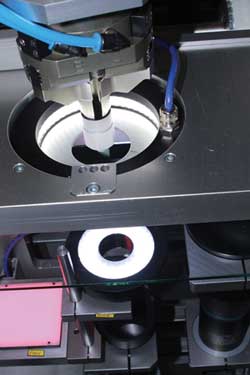
Visotect’s automated test system precisely measures threads:
A robot moves the test pieces into the field of vision of the cameras, which take several pictures with different illumination. Besides the evaluation program, the decisive factors for determining the accuracy and reliability of measurement were primarily the adapted optical design, the type of illumination and high-quality lenses.
The main target groups for Vision 2012 will be the machine vision industry itself, the electrotechnical and electronics industries, the automotive industry and automotive component suppliers, the mechanical engineering industry and the medical technology sector.
Vision in auto construction
Innovative 2-D and 3-D camera systems are increasing flexibility and efficiency in automobile and auto component production – and helping manufacturers to reduce costs as well. The latest developments in this technology will be on display at Vision 2012.
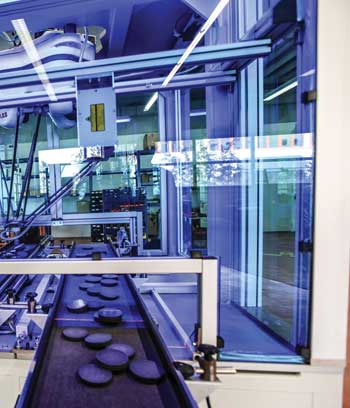
With the aid of 3-D recognition technology, a high-speed robot on the production line can work faster and more accurately. Courtesy of robomotion GmbH and Fraunhofer IPA.
The automotive industry and automotive component suppliers often are pioneers of advanced machine vision technologies, thanks to their goal of constantly improving product quality and reducing production costs while also increasing model and component diversity. Automobile producers and their component suppliers are the main customers for machine vision technologies, accounting for one-quarter of all sales in the German machine vision industry in 2010, according to the VDMA Machine Vision Group.
Smart cameras and 3-D vision are two of the biggest technologies supporting the auto production industry, and Vision Stuttgart organizers say that they will be well represented at the event.
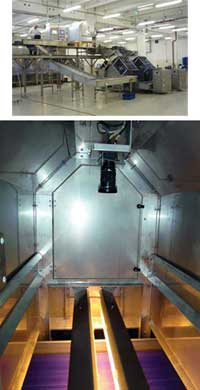
Machine vision is growing in manufacturing- and production-related applications. ISW GmbH, in cooperation with the mechanical engineering company A&B Verpackungsmaschinen Manufaktur, offers products such as a complete solution for quality inspection of fresh bread rolls and other bakery products. Images courtesy of Messe Stuttgart.
Smarter systems are likely to reduce training time and associated costs in various industries. “To date, machine vision systems have been primarily installed and operated by specialists,” said Nicole Rüffer, marketing manager at ISRA Vision. “In future, an increasing number of users will use machine vision solutions without any special knowledge because these technologies are predestined for many other industries besides the automotive industry.”
Intuitive operation, attractive user interfaces and properly functioning automation represent challenges for the future, Rüffer added. “Complex parameter settings must be avoided at all cost, whereby the self-learning capability of the systems must become even better,” she said.
Medical Discovery Tour
For the medical sector, 2012 will offer the second annual Medical Discovery Tour, which will feature vision systems and services for biomedical applications. Last year, 42 exhibitors took part; as of early July, 30 had signed up for 2012.
Because the percentage of visitors from the medical technology industry had increased substantially in 2010, the Medical Discovery Tour was created for Vision 2011 and attracted 43 exhibitors straightaway with its special exhibits; not surprisingly, the proportion of visitors from the medical technology industry rose from 8 to 11 percent.
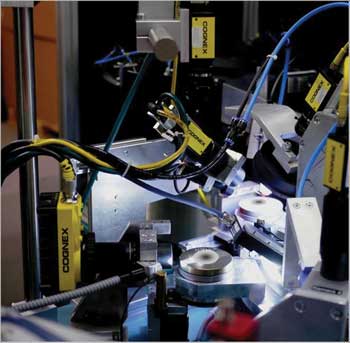
Engineers at Visuelle Technik GmbH have successfully developed and installed a multicamera system comprising three area-scan and two line cameras to inspect shaft seal rings for the automotive component supply industry. The shaft seal rings are inspected for highly sensitive individual defects.
“Medical technology is an important sales market for our cameras, where the focal points are maximum demands on product quality and reliability,” said Mirko Benz, a market intelligence specialist at Baumer.
Biomedical technology is an emerging global growth market, and machine vision systems play an important role in this growth; machine vision sales in the medical devices sector rose by nearly 46 percent from 2010 to 2011, which means that these devices account for more than 3 percent of total machine vision sales.
Imaging systems support the work of doctors and surgeons through the early detection and diagnosis of abnormalities, in image-guided or robot-controlled surgery, and even in producing 3-D models or implants. Machine vision systems that support simulation devices also can be used for training medical personnel.
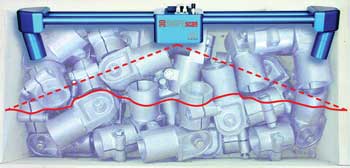
With the aid of the 3-D SHAPEscan sensor from ISRA Vision, a robot can look down and therefore fetch unsorted parts from a box for transfer to the production process. This increases flexibility, saves space and reduces costs, according to the manufacturer. Courtesy of Messe Stuttgart.
“Due to the large number of applications, many different requirements must be taken into account in the area of medical technology,” Benz said. “They may include extremely high resolutions, support for invisible light – e.g., near-infrared light – or excellent color fidelity.”
System integration
Various individual factors figure into not only medical applications but also nearly every vision application. “Complex machine vision applications do not need an ‘off the peg’ solution, but, instead, call for individual adaptation to the problems,” said Catrin Urbanneck, software development manager at GPP Chemnitz mbH.
System integrators often are pioneers of a sort. “No production line and, in particular, no requirement relating to a system is identical to another,” said Angelika Wichmann, managing director of ISW GmbH.
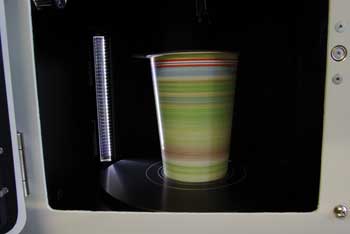
Solin AG has developed a laboratory system with learning capabilities for quality assurance. The test system optically scans the article removed from the production process from all sides at high resolution and compares recorded data with the specified data from a database. Deviations from the target value are displayed immediately.
The trade show’s Integration Area will give pioneers such as system integrators and solution providers their own platform; the Application Park will offer live demonstrations of quality control in production as well as practical seminars during the Vision Academy, which will feature application and technology know-how for end users, system vendors, mechanical engineers and newcomers to machine vision.
“[The Integration Area] is the starting point for the end user,” Walter said. “Here, the end user can find a solution and develop contacts with system integrators.”
Other offerings
In keeping with the trade fair’s tradition of furthering training in the industry and promoting idea exchanges in market and technology trends, standardization, innovation and applications, the accompanying program will again feature Industrial Vision Days, a lecture series organized by the VDMA Machine Vision Group. Keynote speakers at this event come from research and industry and, in approximately 40 presentations, will present new developments in machine vision applications.
In addition, the Vision Award and accompanying €5000 prize will be presented for the 20th time to recognize achievement in the development of machine vision technologies or application solutions. The Austrian Institute of Technology in Vienna won this award in 2011 for its tiny optical 3-D scanner, designed for digital dental measurement and modeling in dental orthopedics and orthodontics.
Another special show, International Machine Vision Standards, explains the benefits and practical use of vision standards. High-speed interfaces such as CoaXPress and Camera Link HS, for example, are the focal points here. This special offering is organized by AIA, EMVA and JIIA.
At this year’s Career Center, university graduates, young professionals and experienced engineers can receive career coaching and advice from experts with wirth + partner. A job board will present exhibitors’ current job openings, and these postings also will be available on the Vision website.
The machine vision community and the Vision trade fair have grown up together and also helped each other to grow, according to the event’s organizers. “Some of today’s key players have been there from the start – that’s what we have in common,” Walter said. “And many new exhibitors have come on board in recent years.”
Published: September 2012